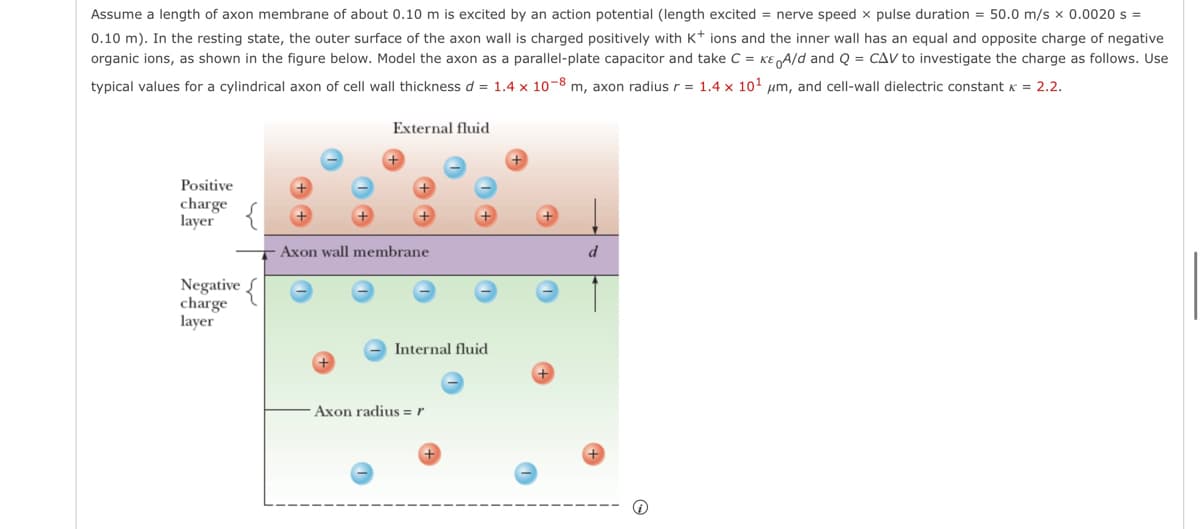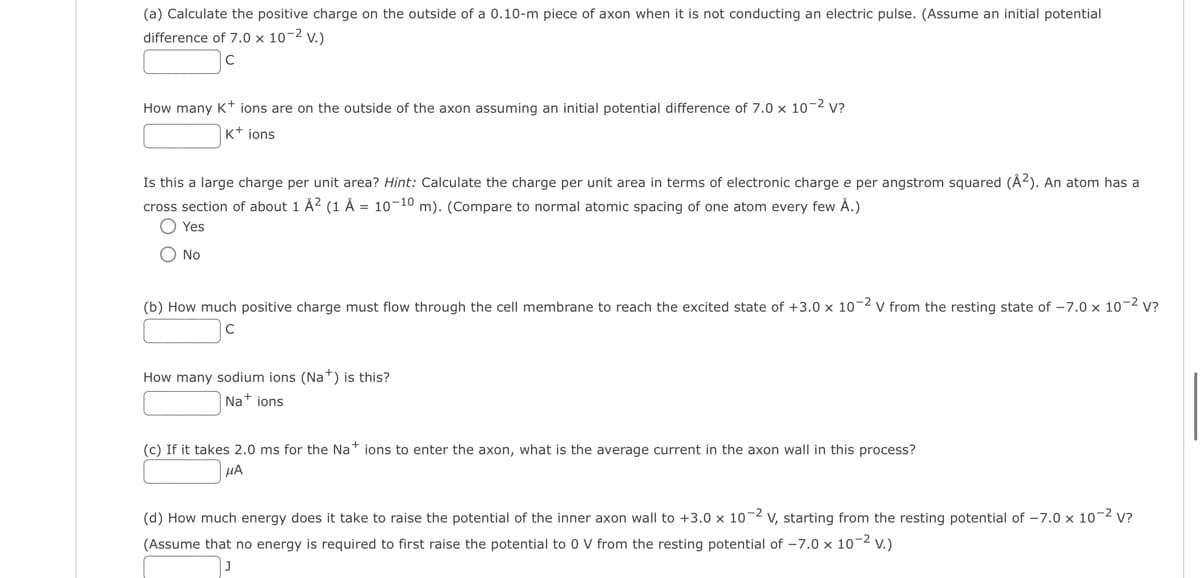Assume a length of axon membrane of about 0.10 m is excited by an action potential (length excited = nerve speed x pulse duration = 50.0 m/s x 0.0020 s = 0.10 m). In the resting state, the outer surface of the axon wall is charged positively with K+ ions and the inner wall has an equal and opposite charge of negative organic ions, as shown in the figure below. Model the axon as a parallel-plate capacitor and take C = KE A/d and Q = CAV to investigate the charge as follows. Use typical values for a cylindrical axon of cell wall thickness d = 1.4 x 10-8 m, axon radius r = 1.4 x 10¹ μm, and cell-wall dielectric constant x = 2.2. Positive charge layer Negative { charge layer External fluid Axon wall membrane Internal fluid Axon radius = r + d
Assume a length of axon membrane of about 0.10 m is excited by an action potential (length excited = nerve speed x pulse duration = 50.0 m/s x 0.0020 s = 0.10 m). In the resting state, the outer surface of the axon wall is charged positively with K+ ions and the inner wall has an equal and opposite charge of negative organic ions, as shown in the figure below. Model the axon as a parallel-plate capacitor and take C = KE A/d and Q = CAV to investigate the charge as follows. Use typical values for a cylindrical axon of cell wall thickness d = 1.4 x 10-8 m, axon radius r = 1.4 x 10¹ μm, and cell-wall dielectric constant x = 2.2. Positive charge layer Negative { charge layer External fluid Axon wall membrane Internal fluid Axon radius = r + d
Elements Of Electromagnetics
7th Edition
ISBN:9780190698614
Author:Sadiku, Matthew N. O.
Publisher:Sadiku, Matthew N. O.
ChapterMA: Math Assessment
Section: Chapter Questions
Problem 1.1MA
Related questions
Question
Assume a length of axon membrane of about 0.10 m is excited by an action potential (length excited = nerve speed × pulse duration = 50.0 m/s × 0.0020 s = 0.10 m). In the resting state, the outer surface of the axon wall is charged positively with k* ions and the inner wall has an equal and opposite charge of negative
organic ions, as shown in the figure below. Model the axon as a parallel-plate capacitor and take C = KEA/d and Q = CAV to investigate the charge as follows. Use
typical values for a cylindrical axon of cell wall thickness d = 1.4 x 10-8 m, axon radius r = 1.4 x 101 um, and cell-wall dielectric constant k = 2.2.

Transcribed Image Text:Assume a length of axon membrane of about 0.10 m is excited by an action potential (length excited = nerve speed x pulse duration = 50.0 m/s x 0.0020 s =
0.10 m). In the resting state, the outer surface of the axon wall is charged positively with K+ ions and the inner wall has an equal and opposite charge of negative
organic ions, as shown in the figure below. Model the axon as a parallel-plate capacitor and take C = KE A/d and Q = CAV to investigate the charge as follows. Use
typical values for a cylindrical axon of cell wall thickness d = 1.4 x 10-8 m, axon radius r = 1.4 x 10¹ μm, and cell-wall dielectric constant x = 2.2.
Positive
charge
layer
Negative {
charge
layer
External fluid
Axon wall membrane
Ⓡ
Internal fluid
Axon radius = r
+
d

Transcribed Image Text:(a) Calculate the positive charge on the outside of a 0.10-m piece of axon when it is not conducting an electric pulse. (Assume an initial potential
difference of 7.0 x 10-² V.)
с
How many K+ ions are on the outside of the axon assuming an initial potential difference of 7.0 x 10-² V?
K+ ions
Is this a large charge per unit area? Hint: Calculate the charge per unit area in terms of electronic charge e per angstrom squared (A²). An atom has a
cross section of about 1 Ų (1 Å= 10-10 m). (Compare to normal atomic spacing of one atom every few Å.)
O Yes
O No
(b) How much positive charge must flow through the cell membrane to reach the excited state of +3.0 x 10-2 V from the resting state of -7.0 x 10-² V?
How many sodium ions (Na+) is this?
Na+ ions
(c) If it takes 2.0 ms for the Nations to enter the axon, what is the average current in the axon wall in this process?
HA
(d) How much energy does it take to raise the potential of the inner axon wall to +3.0 x 10-2 V, starting from the resting potential of -7.0 x 10-² V?
(Assume that no energy is required to first raise the potential to 0 V from the resting potential of -7.0 x 10-² V.)
J
Expert Solution
This question has been solved!
Explore an expertly crafted, step-by-step solution for a thorough understanding of key concepts.
This is a popular solution!
Trending now
This is a popular solution!
Step by step
Solved in 3 steps with 3 images

Recommended textbooks for you

Elements Of Electromagnetics
Mechanical Engineering
ISBN:
9780190698614
Author:
Sadiku, Matthew N. O.
Publisher:
Oxford University Press

Mechanics of Materials (10th Edition)
Mechanical Engineering
ISBN:
9780134319650
Author:
Russell C. Hibbeler
Publisher:
PEARSON

Thermodynamics: An Engineering Approach
Mechanical Engineering
ISBN:
9781259822674
Author:
Yunus A. Cengel Dr., Michael A. Boles
Publisher:
McGraw-Hill Education

Elements Of Electromagnetics
Mechanical Engineering
ISBN:
9780190698614
Author:
Sadiku, Matthew N. O.
Publisher:
Oxford University Press

Mechanics of Materials (10th Edition)
Mechanical Engineering
ISBN:
9780134319650
Author:
Russell C. Hibbeler
Publisher:
PEARSON

Thermodynamics: An Engineering Approach
Mechanical Engineering
ISBN:
9781259822674
Author:
Yunus A. Cengel Dr., Michael A. Boles
Publisher:
McGraw-Hill Education

Control Systems Engineering
Mechanical Engineering
ISBN:
9781118170519
Author:
Norman S. Nise
Publisher:
WILEY

Mechanics of Materials (MindTap Course List)
Mechanical Engineering
ISBN:
9781337093347
Author:
Barry J. Goodno, James M. Gere
Publisher:
Cengage Learning

Engineering Mechanics: Statics
Mechanical Engineering
ISBN:
9781118807330
Author:
James L. Meriam, L. G. Kraige, J. N. Bolton
Publisher:
WILEY